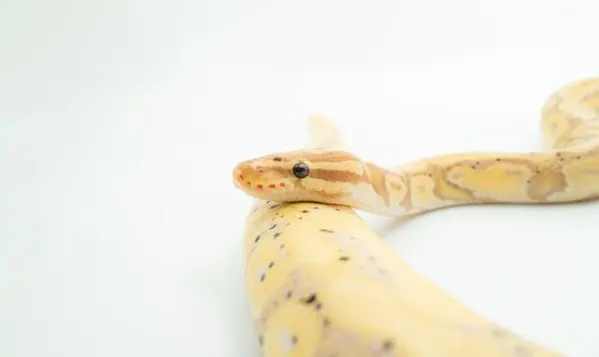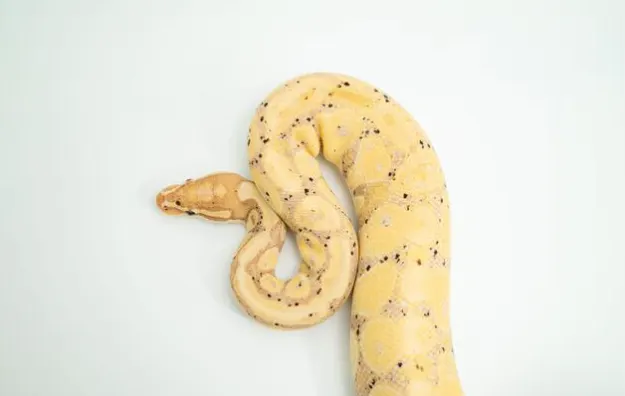The banana ball python, known scientifically as Python regius, is a captivating reptile that has garnered significant attention among snake enthusiasts and breeders alike. With its striking appearance and relatively easy care requirements, it’s no wonder that this morph has become one of the most sought-after pet snakes. In this blog post, we’ll dive into the intriguing world of the banana ball python, exploring its characteristics, habitat, care requirements, and much more.
Table of Contents
Scientific Classification and Conservation Status
The banana ball python belongs to the kingdom Animalia, phylum Chordata, class Reptilia, order Squamata, and family Pythonidae. Its genus is Python, and its scientific name is Python regius. Despite the ongoing threats faced by many wildlife species, the banana ball python is classified as “Least Concern” on the IUCN Red List. This status reflects its relatively stable population in the wild, although it’s important to note that the specific banana morph is largely a product of selective breeding in captivity.

Physical Characteristics
One of the most striking features of the banana ball python is its vibrant coloration. The body of this snake can range from a basic tan to a more ethereal lilac, but the most distinctive feature is the bright yellow spots that dot its scales. These spots give the snake its “banana” moniker and set it apart from other ball python morphs. In terms of size, female banana ball pythons can reach up to four feet in length, while males are typically smaller, growing to about 2.5 feet.
Fascinating Facts About Banana Ball Pythons
- High Initial Value: The first banana ball python sold for a staggering $25,000. Today, these snakes are much more affordable, often available for less than $100.
- Genetic Variations: Some banana ball pythons can be born as super banana morphs. These snakes do not develop freckles as they age, a trait that is particularly appealing to breeders.
- Varied Morphs: Since the initial development of the banana ball python, more than a dozen different morphs have emerged. These include creatively named variations like the banana spider, banana clown, and black pastel banana.
Natural Habitat and Distribution
In the wild, ball pythons are native to West and Central Africa, inhabiting countries such as Cameroon, Senegal, Ghana, Chad, Sudan, and Uganda. They thrive in the tropical Sub-Saharan ecosystem, favoring open forests and grasslands. Their natural coloration helps them blend into the brush and shrubs, providing effective camouflage from both predators and prey. However, the bright coloration of the banana morph would be a liability in the wild, making it a rarity outside of captivity.
Behavior and Temperament
Banana ball pythons are known for their docile and mellow nature, making them an excellent choice for pet owners. These snakes are shy and rarely aggressive, preferring to retreat into a ball when threatened—a behavior that gives the species its common name. They are neither anxious nor overly curious, content to spend much of their time lounging around their enclosure. However, it’s important to handle them gently and respect their space, especially if they exhibit defensive behaviors.
Care Requirements
Caring for a banana ball python involves creating an environment that mimics its natural habitat. Here are some key considerations:
- Enclosure: A suitable enclosure should measure at least one foot by one and a half feet by three feet to provide adequate space for the snake to move and stretch out.
- Temperature and humidity: Maintaining proper temperature and humidity levels is crucial. The enclosure should have a gradient of warm and cool spots, with the warm side kept around 88-92°F and the cool side around 78-80°F. Humidity should be regulated between 50% and 70%.
- Substrate: Use a substrate that retains humidity well, such as cypress mulch or aspen shavings. Avoid substrates like pine or cedar, which can be toxic to reptiles.
- Hiding Spots: Provide multiple hiding spots within the enclosure to help the snake feel secure. These can be commercial hide boxes or simple DIY hides made from cardboard or plastic containers.
- Diet: In the wild, banana ball pythons primarily feed on rodents. In captivity, their diet should consist of appropriately sized rats or mice. Offer
food once every 7-10 days for juveniles and every 10-14 days for adults.
Reproduction and Breeding
Banana ball pythons exhibit co-dominant genetic traits, which means that breeding them can produce offspring with predictable coloration and patterns. Breeders often aim to produce super banana morphs by pairing two banana ball pythons together. These super banana ball pythons carry two copies of the dominant gene and retain their vibrant coloration without developing freckles.
Health and Common Issues
While banana ball pythons are generally hardy snakes, they can be prone to certain health issues if not cared for properly. Common problems include:
- Respiratory Infections: Caused by inadequate humidity or temperature fluctuations. Symptoms include wheezing, mucus, and open-mouth breathing.
- Mites and Parasites: Regularly inspect your snake for signs of mites or other parasites. These can be treated with appropriate reptile-safe medications.
- Shedding Problems: Ensure proper humidity levels to help your snake shed its skin completely. Incomplete sheds can lead to retained eye caps and other issues.
The banana ball python is a remarkable example of the beauty and diversity found within the reptile world. Its striking appearance, coupled with its manageable care requirements and docile nature, make it a favorite among snake enthusiasts. Whether you’re a seasoned reptile keeper or a newcomer to the hobby, the banana ball python offers a rewarding and visually stunning pet experience. By understanding its natural history, behavior, and care needs, you can provide a happy and healthy home for this unique snake.

FAQs about Banana Ball Pythons
Q: Are banana ball pythons venomous? A: No, banana ball pythons are not venomous. They are nonvenomous constrictors, meaning they subdue their prey by constriction.
Q: How do banana ball pythons hunt? A: Banana ball pythons are ambush predators. They lie in wait for their prey and then strike quickly, wrapping their coils around the prey to suffocate it.
Q: What do banana ball pythons eat? A: In the wild, banana ball pythons primarily eat rodents. In captivity, they can be fed mice, rats, and occasionally other small mammals.
Q: How big do banana ball pythons get? A: Adult female banana ball pythons can grow up to four feet long, while males typically reach around 2.5 feet.
Q: How long do banana ball pythons live? A: With proper care, banana ball pythons can live between 20-30 years in captivity.
Q: Are banana ball pythons aggressive? A: No, banana ball pythons are known for their docile nature. They are generally shy and prefer to curl into a ball when threatened.
Q: What is the difference between a banana ball python and an albino ball python? A: The main difference is in their eye color. Albino ball pythons have bright red eyes, while banana ball pythons have darker eyes.
- Enchi Ball Python: A Unique and Stunning Morph of Python regius - March 27, 2025
- Emerald Tree Monitor: The Enigmatic Green Guardian of the Rainforest - March 26, 2025
- The Egyptian Cobra (Naja haje): A Fascinating Serpent - March 25, 2025
